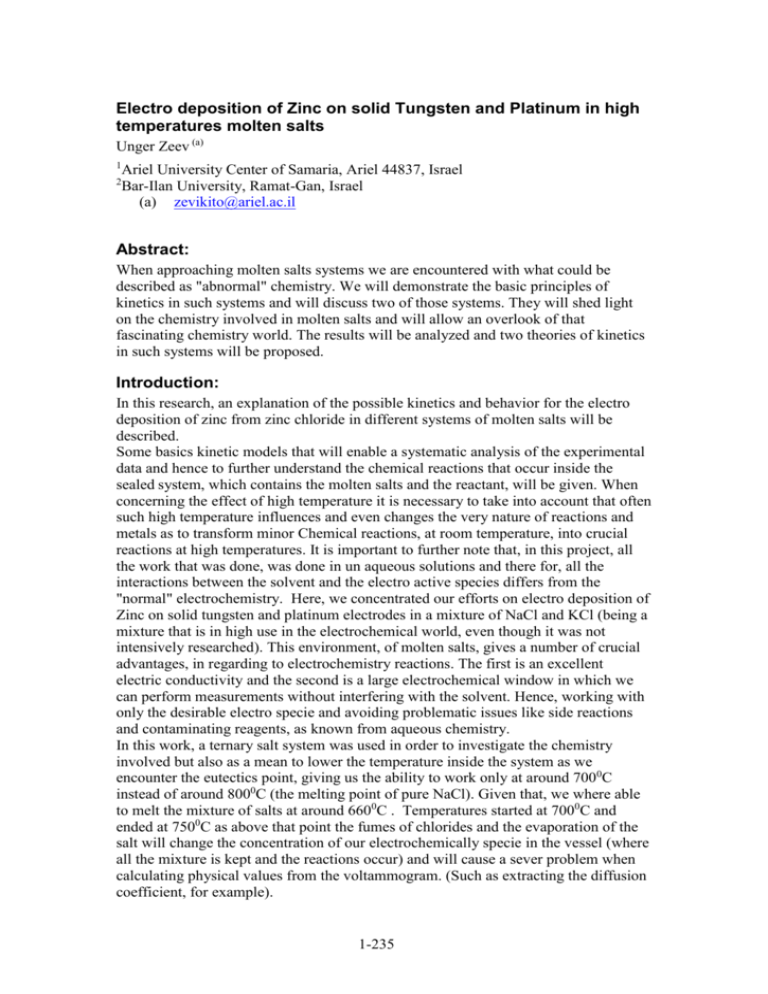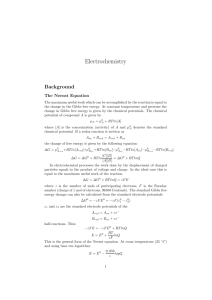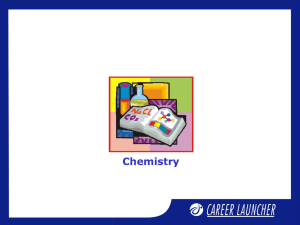1-235
advertisement

Electro deposition of Zinc on solid Tungsten and Platinum in high temperatures molten salts Unger Zeev (a) 1 2 Ariel University Center of Samaria, Ariel 44837, Israel Bar-Ilan University, Ramat-Gan, Israel (a) zevikito@ariel.ac.il Abstract: When approaching molten salts systems we are encountered with what could be described as "abnormal" chemistry. We will demonstrate the basic principles of kinetics in such systems and will discuss two of those systems. They will shed light on the chemistry involved in molten salts and will allow an overlook of that fascinating chemistry world. The results will be analyzed and two theories of kinetics in such systems will be proposed. Introduction: In this research, an explanation of the possible kinetics and behavior for the electro deposition of zinc from zinc chloride in different systems of molten salts will be described. Some basics kinetic models that will enable a systematic analysis of the experimental data and hence to further understand the chemical reactions that occur inside the sealed system, which contains the molten salts and the reactant, will be given. When concerning the effect of high temperature it is necessary to take into account that often such high temperature influences and even changes the very nature of reactions and metals as to transform minor Chemical reactions, at room temperature, into crucial reactions at high temperatures. It is important to further note that, in this project, all the work that was done, was done in un aqueous solutions and there for, all the interactions between the solvent and the electro active species differs from the "normal" electrochemistry. Here, we concentrated our efforts on electro deposition of Zinc on solid tungsten and platinum electrodes in a mixture of NaCl and KCl (being a mixture that is in high use in the electrochemical world, even though it was not intensively researched). This environment, of molten salts, gives a number of crucial advantages, in regarding to electrochemistry reactions. The first is an excellent electric conductivity and the second is a large electrochemical window in which we can perform measurements without interfering with the solvent. Hence, working with only the desirable electro specie and avoiding problematic issues like side reactions and contaminating reagents, as known from aqueous chemistry. In this work, a ternary salt system was used in order to investigate the chemistry involved but also as a mean to lower the temperature inside the system as we encounter the eutectics point, giving us the ability to work only at around 7000C instead of around 8000C (the melting point of pure NaCl). Given that, we where able to melt the mixture of salts at around 6600C . Temperatures started at 7000C and ended at 7500C as above that point the fumes of chlorides and the evaporation of the salt will change the concentration of our electrochemically specie in the vessel (where all the mixture is kept and the reactions occur) and will cause a sever problem when calculating physical values from the voltammogram. (Such as extracting the diffusion coefficient, for example). 1-235 Our theory was that the whole process is controlled by diffusion. And if so, finding the reaction limiting step we will give us the tools to determine the kinetics and mechanism for the reactions. (Hence the mathematical analysis, in which we can calculate the diffusion coefficient according to the known. Randles – Sevcik equation: ip = 0.4463 (nF)3/2/(RT)1/2D1/2C*1/2 and in accordance to Berzins and Delahay equation : ip = 0.6105 (nF)3/2/(RT)1/2D1/2C*1/2 where D stands for the diffusion coefficient, and is the scan rate). We will demonstrate the differences between the two systems and the regarding results and ideas concerning them both. As will be explained later in the text, the two differs in the rate determining step and therefore, the aspect toward each of them will be different. An explanation of the difference in the systems will count on both mathematical solutions and on analytical review and spectral analysis. This theory, of a diffusion controlled system, will not answer questions regarding the second system and there for, a second theory will be given and proven (regarding to the system in which we electrodeposited Zinc on a solid Pt electrode). When comparing the two systems we will in fact compare two very different types of reactions, and when placed along side to each other, will give us a perspective of molten salts chemistry. Experimental Section We employ cyclic voltammetry (CV) in order to investigate and perform the redox and the oxidation reactions upon the solid working electrode. Using the CV is highly useful as an analysis of the kinetics in the system which is being investigated and is happening at the same time with the actual reaction. A three electrodes cell was in use, in which in all systems, the counter electrode was a spiral tungsten wire of 1mm diameter and the reference electrode was a plain 1mm width tungsten wire. In the second system a Pt wire was taken as the working electrode and in the first system a tungsten wire was used also as the working electrode. The two salts were mixed (KCl and NaCl) with the electrochemical specie (ZnCl2) and inserted into a ceramic vessel, following insertion to a special alloy container and into the inert furnace. Pic. 1 the three electrodes are stuck in the melt (the mixture of salts after the work with CV at high temperature). Special precautions had to be taken as the ZnCl2 is very hygroscopic and so, a procedure was plotted in order to rid all the moisture in the air, as we did not want to let the metal oxidize by the water in the air: 1. Vacuum the furnace for about half an hour 2. Slowly raise the pressure up to a single atmosphere while pumping in an inert gas. 3. In order to make sure that the system is dry, the temperature was raised slowly up to about 1500C. 4. Followed by another heating, this time almost to the verge of melting the mixture of salts and ZnCl2. 5. Heat the system to 7000C. It is worth noticing that there has been a great effort trying to complete as much work as possible inside a glove bag as all the reagents involved in this research are hygroscopic, especially the ZnCl2. The gas used in order to keep the system inert was normally nitrogen (5\9) but there has been some use in Argon as well. All the work 1-236 was done in a Carbolite inert furnace and the measurements were taken using an Autolab potentiostat\ galvanostat Measurements where taken at different sets of temperatures and different sets of ingredients (different concentrations of the ZnCl2) in order to be able to compare different settings of the same system. Each arrangement was prepared as described earlier and was set of using the cyclic voltammetry. In order to make sure that the results have derived from the actual reaction that we wanted to study and were not influenced by a nucleation process and that the nucleation is not worth noticing, we also employed a chronoamperometry analytical procedure (as known, in voltammetry, the peak of the current, as showed in the voltammogram, may be influenced by the nucleation step and as we are dealing with high temperature chemistry we could not over look that question). Analysis was not done strictly by mathematical tools, but also using a S.A.M which gave us an exact look of our working electrodes and was of a crucial proof that our theory was, in fact, true. Our initial concept of how the system should probably work was accurate for the system in which we performed electro deposition of Zinc on solid W electrode. When we analyzed the second system, where the Zinc was electro deposited on solid Pt electrode we had built another kinetics theory, which is in high stages of work, as this article is being written. Result and discussion We now have to assume a logic kinetic model for this behavior, which means that we have to find what the rate determining step is and what is the reaction that takes place there. 1. The first system that will be analyzed is in which our original idea was proven, accurate. This being the system in which Zinc was electrodeposited on a solid W as a working electrode. Concentration of the Zinc chloride that was added was averaging at around 3.16E-05 mol\ml and was deposited at 7000C, 7100C, 7300C, 7500C with scan rates rating from 20 mV\S to 1200 mV\S.. A typical voltammogram of that system is shown is fig 1. Where the X axis stands for the Voltage (measured in volts) and the Y axis stands for the current (measured in amp). Fig1. 200 mV\S at 7000C As can very clearly seen in fig. 1 the current is very high (if compared to "normal" aqueous chemistry) and the catodic peak is clear. We could easily extract the peak current and divide it by the area of working electrode that was sank is the mixture in order to receive the peak current density. As shown before, using the Randles – Sevcik equation and the Berzins Delahay equation we calculated the diffusion coefficient. The Randles – Sevcik model is considered to be true in the case of ideal systems. Clearly, this is not the case here, as we are talking about molten salts, and as that being the case, there are certainly numerous interactions inside the solvent and between the electro active specie and the solvent itself. Because of that fact the Berzins and Delahay model (5) gave what might be considered the real coefficient 1-237 constant. A S.A.M was employed on the working electrode sample and clearly showed that the Zinc was layered nicely on the working electrode, as we expected. The sample of the working electrode was taken by means of chrono amperometry at the peak voltage and was left for an hour; until we had no doubt that the reaction has ended (the electro deposition on the solid working electrode). In order to conclude that this electro deposition is, in fact, controlled by diffusion, we extracted the root of the scan rate versus the peak current density and encountered an almost linear graph, as shown in fig. 2 (Randles-Sevcik plot). This also proves the reversibility of the process and is a strong conformation to our initial theory. Combined with the results of the map and line scanning of the S.A.M. we can conclude that our kinetic model is the right one and that the system is indeed, diffusion controlled. Further more, According to all the information we collected we can assume in good confidences that the reaction is carried out in the following manner: there are two electrons moving at once from the metal to the reactant back and forth (depending on the voltage we employ on the system using the CV) and the whole process is relatively simple and is controlled by diffusion. Meaning that the rate of the reaction is determined by how fast the reactant can move toward the working electrode from the depth of the phase. That rate is measurable, and indeed was calculated, as said before. We calculated the diffusion coefficient 750C and showed that it is consistent with logic – the constant raised as temperature rose. Conclusion of that calculation is shown in fig. 3 30 25 20 15 10 0 0 -0.1 5 -0.2 y = -0.0222x - 0.0329 R2 = 0.9982 -0.3 SR^0.5 -0.4 )SR^0.5( ליניארי ip 35 Fig 2.showes the Randles-Sevcik plot -0.5 -0.6 -0.7 -0.8 סיכום SR^0.5 3.50E-06 3.00E-06 1סידרה )1ליניארי (סידרה D 2.50E-06 Fig. 3 shows the conclude constant (D) versus the temperature. 2.00E-06 1.50E-06 1.00E-06 5.00E-07 0.00E+00 690 700 710 720 730 740 750 760 Temp 2. When coming to work with the second system - electro deposition of Zinc on solid Pt we anticipated to see similar results, only with probably two catodic peaks, as we are referring to Pt . And indeed, the scan showed two peaks. However, as it turned out, we had difficulty determining that this system was in fact diffusion controlled. We employed a S.A.M on the sample (the working electrode) and the result of the mapping scan showed that the electro deposition of Zinc on top of the Pt working 1-238 electrode was random and scarce. As of now, we can not explain with out a shadow of a doubt why that is. We suggest two alternative kinetics models. 2.1. It is reasonable to assume that Zinc is not likely to react with the platinum solid working electrode with ease and we are required to adjust our system in such a manner that the reactions will yield the solid Zinc on top of the solid Pt in a clear deposit. It is possible that the absorption to another element, in our case, the Pt, can interfere with the desired reaction and hence the result. Since that being the case, the Zinc is then "reluctant" to further accept another electron and hence the low rate of the reaction. As evidence we can clearly see the random dispersion of the Zinc on top of the Pt electrode when examining the working electrode in S.A.M. (using map and line scanning) and the small amount of Zinc that actually went through the reaction and was deposited on the working electrode. If in fact, it was a diffusion controlled reaction then we were supposed to see a nicely layer of deposited Zinc on top of the working electrode. But, as said before, the Zinc was scarcely seen on the working electrode and even then, was in a random order .If that being the case, then we will see the Zinc on top of the counter and reference electrodes. This is being prepared for spectroscopic view as this paper is written and results have not yet received. If that is the case then there is no reaction happening in this system on the Pt electrode. 2.2. On the other hand it is reasonable to assume that because we are talking about Pt then there is some kind of absorption happening on the surface of the solid Pt metal, but only after the Zn2+ receives a single electron. There are two peaks after employing CV and need to be explained. One can easily belong to the actual electron transfer and the second to the absorption. That gives the second hypothesis; meaning that there is a reaction and that it is preformed in the following manner: the Zn2+ receives only one electron. It is then absorbed on the Pt surface and we are encountered with a fairly stable transition state where the Zinc is still Zn+1. Hence, there is a large energetic barrier and this causes for the deceleration of the reaction. As this article is written, the work to prove either theory is in progress, mainly by mathematical tools. The sample here was achieved as described earlier in section 1. A typical voltammogram of that system is showed in fig.3 showing the two peaks. Fig3. 200 mV\S at 7000C Where the X axis stands for the Voltage (measured in volts) and the Y axis stands for the current (measured in amp). It will be interesting to prove that point by using the same system, but this time with Pt also as counter and as reference electrode and compare those reactions with what was received when the counter and the reference electrode were solid W. If we will see Zinc on top of the electrode there, then the Zinc is reactive with Pt and in that case, it is likely that the kinetics is what was described in section 2.2. With that, we have a good overview of the electrochemistry world, concerning molten salts and a good grasp of what is actually happening inside those systems. We have encountered two very different systems and where able to analyze in good precision what happens in one and give a logical theory as to the other. 1-239 Acknowledgements To A. Lugovskoy whom with out, this work would have never came into light, to Prof. M. Zinigrad for the council and all the members of the Advanced Material Research Centre of the university centre of Samaria in Ariel. Reference 1. H. A. Andreasen and N. J. Bjerrum Chloro Complexes in Molten Salts. IV. A Potentiometric and Spectrophotometric - Study of the System KCl-FeC13 in the 'Temperature Range 275-350 2.F. Argoul, A. Arneodo, G. Grasseau Self similarity of diffusion limited aggregates and Electro deposition clusters 3. Steven Christian LANS The Limiting Phenomena at the Anode of the Electrowinning of Zinc from Zinc Chloride in a Molten Chloride Electrolyte. 4. Alex Lugovskoy Electrochemical Determination of Diffusion Coefficients of Iron (II) Ions in Chloride Melts at 700-750oC 5. T Berzins, P Delahay, J. Am. Chem. Soc., 1953, 75(3) , 555 1-240





